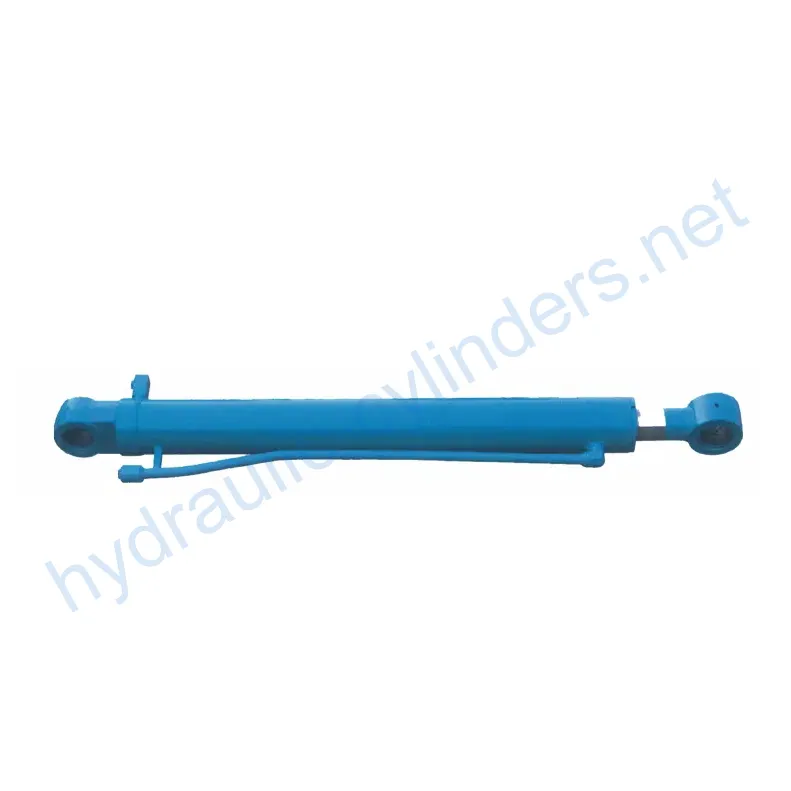Bucket Cylinder For Kato Small Excavator HD900-5-7
Bucket Cylinder For Kato Small Excavator HD900-5-7
Introduction to Bucket Cylinder
The bucket cylinder is a specially designed hydraulic cylinder used to control the movement of the bucket in heavy machinery such as excavators, backhoe loaders, and front loaders. Its main function is to enable the lifting, lowering, and tilting of the bucket, making it easier for various material handling tasks. In the hydraulic system, the bucket cylinder achieves precise control of the bucket by utilizing the pressure changes of hydraulic oil, allowing operators to efficiently handle heavy loads and adapt to complex work environments and diverse operational needs.

Features of Bucket Cylinder
- High Strength and Durability: Typically made from high-strength steel or aluminum, the bucket cylinder is capable of withstanding high pressure and heavy loads, adapting to harsh working environments. Its design considers wear resistance and corrosion resistance to extend its lifespan.
- Efficient Hydraulic Operation: By utilizing the pressure of hydraulic oil, the bucket cylinder achieves smooth extension and retraction actions, providing quick response to control commands and delivering powerful pushing and pulling forces suitable for handling heavy loads and complex tasks.
- Various Types: Bucket cylinders can be selected as single-acting (hydraulic pressure used in one direction only) or double-acting (hydraulic pressure used in both directions) cylinders to meet different operational requirements. Some models are telescopic, allowing greater extension without increasing external dimensions, making them suitable for applications with limited space.

Applications of Bucket Cylinder
The bucket cylinder finds its applications in various equipment:
- Construction Equipment: Found in excavators, they are crucial for digging, loading, and moving soil or debris. In backhoe loaders, the bucket cylinder aids in both digging and lifting.
- Agricultural Machinery: Used in front loaders for scooping, lifting, and transporting soil, hay, and other materials.
- Excavators: The bucket cylinder enables digging actions by allowing the bucket to penetrate the soil.
- Loaders: In front loaders, they assist in lifting and dumping goods efficiently.
Design Considerations and Selection Criteria
When designing and selecting bucket cylinders, several factors are taken into account:
- Bearing Capacity: The bucket cylinder must be designed to withstand the expected loads and forces encountered during operation.
- Sealing: Various sealing components, such as piston seals and rod seals, are used to ensure effective sealing and prevent leakage.
- Durability: The cylinder body and threaded ends undergo precise surface treatment to enhance wear resistance and prolong service life.
- Safety: Safety measures are incorporated in the design to prevent accidents and ensure operator protection.
- Maintainability: Considerations are made to facilitate maintenance and repair tasks, enabling efficient servicing of the bucket cylinder.

Sealing and Lubrication of the Cylinder
The bucket cylinder utilizes various sealing components, such as piston seals and rod seals, which are made of wear-resistant materials like polyurethane and nitrile rubber. The cylinder body and threaded ends undergo fine surface treatment to improve wear resistance. Regular lubrication with the appropriate amount of hydraulic oil is necessary to ensure smooth operation.
Regular Inspection and Preventive Maintenance Measures
To maintain the optimal performance of the bucket cylinder, regular inspection and preventive maintenance measures should be taken:
- Regular inspections: Periodic checks should be conducted to identify any potential issues or signs of wear.
- Proper lubrication: Adequate lubrication is essential to ensure smooth operation and prevent premature wear.
- Seal replacement: If any seals show signs of damage or leakage, they should be promptly replaced to maintain optimal sealing performance.
- Calibration checks: Periodic calibration checks should be performed to ensure the cylinder operates within the specified parameters.

Safety Considerations and Environmental Factors
When using bucket cylinders, it is important to prioritize safety measures to prevent accidents and minimize environmental impact.
Troubleshooting and Common Issues
Common issues that may arise with bucket cylinders include:
- Leakage: Check for any signs of oil leakage and inspect the sealing components for damage.
- Poor performance: If the cylinder is not operating smoothly or providing sufficient force, check for potential issues with the hydraulic system or worn-out components.
- Irregular movements: If the bucket cylinder exhibits irregular movements or fails to respond to control commands properly, inspect the hydraulic system and check for any obstructions or faults.
Proper troubleshooting techniques and solutions should be applied to diagnose and resolve these problems. Implementing preventive measures can help minimize potential issues.

About Our Company
We are a manufacturer specializing in replacement hydraulic cylinders. With a wide range of product offerings, we have become one of the leading manufacturers and wholesale distributors of hydraulic cylinders in domestic and international markets. We adhere to the principles of excellent quality and rely on industrialized production management strategies in our sophisticated manufacturing workshops. By utilizing technological talent, advanced manufacturing equipment, and professional testing systems, we continuously improve our manufacturing platform, optimize the production route for product quality, and possess strong innovative capabilities. With high efficiency, precision, and quality as our guiding principles, we strive to meet the diverse needs of our customers.

From expertise, international certifications, customized services, production equipment, to after-sales services, we offer a comprehensive introduction to our company.
Author: lyl
参观我们的 VR 工厂
通过以下方式参观我们的 VR 工厂
液压缸应用:


